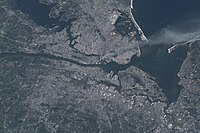
Photo from wikipedia
The destruction of the World Trade Center (WTC) towers on 11 September 2001 released many tons of aerosolized dust and smoke with potential for carcinogenic exposures to community members as… Click to show full abstract
The destruction of the World Trade Center (WTC) towers on 11 September 2001 released many tons of aerosolized dust and smoke with potential for carcinogenic exposures to community members as well as responders. The WTC Environmental Health Center (WTC EHC) is a surveillance and treatment program for a diverse population of community members (“Survivors”), including local residents and workers, present in the NYC disaster area on 9/11 or in the days or weeks following. We report a case series of cancers identified in the WTC EHC as of 31 December 2019. Descriptive characteristics are presented for 2561 cancer patients (excluding non-melanoma skin cancer) and 5377 non-cancer WTC-EHC participants who signed informed consent. We identified a total of 2999 cancer diagnoses in 2561 patients: 2534 solid tumors (84.5%) and 465 lymphoid and hematopoietic tissue cancers (15.5%) with forty-one different cancer types. We describe the distribution, frequency, median age of cancer diagnosis and median latency from 9/11 by cancer site. In addition to common cancer types, rare cancers, including male breast cancers and mesotheliomas have been identified. The current study is the first report on cancer characteristics of enrollees at WTC EHC, a federally designated treatment and surveillance program for local community members affected by the 9/11 terrorist attack on the WTC.
Journal Title: International Journal of Environmental Research and Public Health
Year Published: 2020
Link to full text (if available)
Share on Social Media: Sign Up to like & get
recommendations!